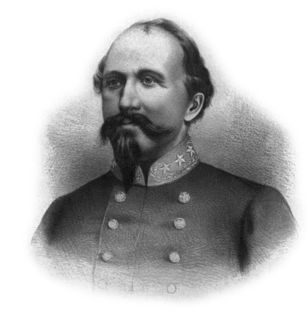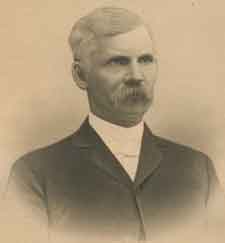
John H. Morgan was a Confederate general in the American Civil War. Morgan never used his middle name of Hunt during the war — it is a post war appellation.
The Battle of Salineville occurred July 26, 1863, near Salineville, Ohio during Morgan's Raid in the American Civil War. Except for the St. Albans (Vermont) Raid, it was the northernmost military action involving the Confederate States Army. The Union victory shattered John Hunt Morgan's remaining Confederate cavalry and led to his capture later that day.

The 5th United States Colored Cavalry was a regiment of the United States Army organized as one of the units of the United States Colored Troops during the American Civil War. The 5th USCC was one of the more notable black fighting units. It was officially organized in Kentucky in October 1864, after its first two battles. It was commanded by Colonel James Brisbin until February 1865, when he took over the 6th US Colored Cavalry. His executive officer, Louis Henry Carpenter, commanded the regiment until 20 March 1866.

Stephen Gano Burbridge, also known as "Butcher" Burbridge or the "Butcher of Kentucky", was a controversial Union general during the American Civil War. In June 1864 he was given command over the Commonwealth of Kentucky, where guerrillas had carried out attacks against Unionists. He imposed martial law and was criticized for punitive actions against persons accused of being guerrillas.

Kentucky was a border state of key importance in the American Civil War. President Abraham Lincoln recognized the importance of the Commonwealth when, in a September 1861 letter to Orville Browning, he wrote:
I think to lose Kentucky is nearly the same as to lose the whole game. Kentucky gone, we cannot hold Missouri, nor Maryland. These all against us, and the job on our hands is too large for us. We would as well consent to separation at once, including the surrender of this capitol.

Louisville in the American Civil War was a major stronghold of Union forces, which kept Kentucky firmly in the Union. It was the center of planning, supplies, recruiting and transportation for numerous campaigns, especially in the Western Theater. By the end of the war, Louisville had not been attacked once, although skirmishes and battles, including the battles of Perryville and Corydon, took place nearby.

Marcellus Jerome Clarke was a Confederate captain who in 1864 became one of Kentucky's most famous guerrillas. He was rumored to be "Sue Mundy", a character publicized by George Prentice, editor of the Louisville Journal.

Bennett Henderson Young was a Confederate officer who led forces in the St Albans raid, a military action during the American Civil War. As a lieutenant of the Confederate States Army, he entered Vermont from Canada and occupied the town of St. Albans.

The Confederate Martyrs Monument at the Jeffersontown City Cemetery in Jeffersontown, Kentucky, marks where four Confederate soldiers were executed "without cause or trial". Their execution was under Order 59, created by Union General Stephen G. Burbridge, known as "Butcher Burbridge" in Kentucky, which called for the execution of four Confederate prisoners for every unarmed Union citizen killed. The total number of executions performed as a result of this order was fifty. The four soldiers commemorated on the stone were Wilson P. Lilly, Rev. Sherwood Hatley, Lindsay Duke Buckner and M. Blincoe.

The Confederate Soldiers Martyrs Monument in Eminence, Kentucky, notes the burial spot of three Confederate prisoners who were shot while imprisoned. The names of the victims were William Datbor (Darbro), William Tighe, and R. W. Yates. It was done in retaliation for the deaths of two African-Americans and authorized by Union General Burbridge's Order 59, which allowed for the execution of Confederate soldiers.

George Dennison Prentice was a newspaper editor, writer and poet who built the Louisville Journal into a major newspaper in Louisville, Kentucky, and the Ohio River Valley, in part by the virulence and satire in its editorials, which some blamed for a bloody election day riot in 1855. A slaveholder, Prentice initially supported Unionist candidate John Bell in the 1860 U.S. Presidential election, and after the American Civil War began urged Kentucky to remain neutral. Both of his sons joined the Confederate States Army, one dying in 1862, and Prentice's editorials lampooned Kentucky's military governor, Union General Stephen G. Burbridge. Prentice later opposed Congressional Reconstruction. He wrote a biography of Henry Clay published in 1831, an 1836 poem published in the McGuffey Readers, and a collection of his humorous essays was published in 1859 and revised after his death.
Sue Mundy was a fictional guerrilla character created by George D. Prentice, the editor of the Louisville Journal. Prentice opposed the heavy-handed military rule of General Stephen G. Burbridge in Kentucky during the American Civil War.

The Second Battle of Cynthiana included three separate engagements during the American Civil War that were fought on June 11 and 12, 1864, in Harrison County, Kentucky, in and near the town of Cynthiana. This was part of Confederate Brigadier General John H. Morgan's 1864 Raid into Kentucky. The battle ultimately resulted in a victory by Union forces over the raiders and ended Morgan's Last Kentucky Raid in defeat. Morgan's command had previously captured the town in the First Battle of Cynthiana, July 17, 1862.

The John B. Castleman Monument, within the Cherokee Triangle of Louisville, Kentucky, was unveiled on November 8, 1913. The model, selected from a competition to which numerous sculptors contributed, was designed by R. Hinton Perry of New York. The statue was erected to honor John Breckinridge Castleman at a cost of $15,000 by popular subscription from city, state, and other commonwealths. The statue is made of bronze, and rests on a granite pedestal. It stands 15-feet high, with a base of 12×20 feet. The monument was placed on the National Register of Historic Places on July 17, 1997, as part of the Civil War Monuments of Kentucky MPS. There have been attempts to remove the statue since January 2019 due to the fact that Castleman was a Major of the Confederate army ; however, all attempts to remove the monument have failed so far.

The Confederate Monument in Georgetown is within the Georgetown Cemetery of Georgetown, Kentucky. It is an unpolished granite obelisk that is twenty feet tall, surrounded by the graves of eighteen former Confederate soldiers. The various reliefs upon the obelisk include crossed cannons, crossed muskets, a drum, and flags. It was placed on the National Register of Historic Places on July 17, 1997 as part of the Civil War Monuments of Kentucky Multiple Property Submission.

The Thompson and Powell Martyrs Monument is a memorial to two Confederate soldiers in St. Joseph, Kentucky. It is on the National Register of Historic Places (NRHP), one of only three NRHP locations in Daviess County, Kentucky that is not in Owensboro, Kentucky.

Lexington, Kentucky was a city of importance during the American Civil War, with notable residents participating on both sides of the conflict. These included John C. Breckinridge, Confederate generals John Hunt Morgan and Basil W. Duke, and the Todd family, who mostly served the Confederacy although one, Mary Todd Lincoln, was the first lady of the United States, wife of President Abraham Lincoln.

The New Haven Battlefield is the area of American Civil War military engagements at the intersection of the Rolling Fork and the former Louisville and Nashville Railroad line between Knoxville and New Haven, Kentucky. The geographic area includes the James Howell Farm and additional combat areas of December 30, 1862.
Henry C. Magruder was a Confederate soldier and guerrilla during the American Civil War. Born in Bullitt County, Kentucky, he took part in several major Western theater, but he is best known for his fate as a guerrilla.
The Battle of Mount Sterling was a minor action in the American Civil War that occurred in June 1864 in Mount Sterling, Kentucky.




















